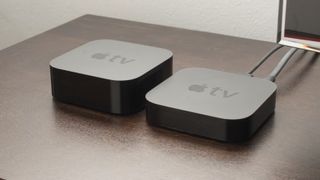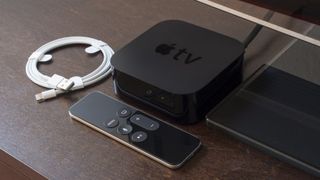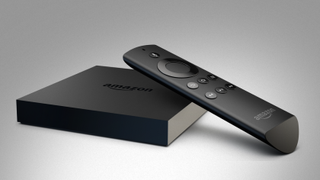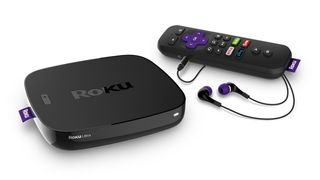Apple TV review
Apple TV is bleeding-edge streaming device that takes some getting used to

OUR VERDICT
Eventually the new Apple TV might be the revolution the Cupertino company promised it would be. But, for right now, it's a middling streaming video player that has a premium remote and a price tag to match.
FOR
- AirPlay with iOS devices
- tvOS is a huge improvement
- Allows third-party apps
AGAINST
- Bluetooth remote needs work
- Pricier than similar devices
The Essential Review
The Apple TV was ahead of its time when it released back in 2015. It featured a new touch remote and a brand-new interface that no one had seen before.
[Update: You didn't think that Apple would stop updating the old Apple TV just because the new Apple TV 4K has been released did you? tvOS 11.2 has just been released, and the update includes a number of benefits for US sports viewers. You'll be able to keep an eye on scores for multiple games while watching just one of them, and you can also set up notifications that'll allow you to swap to games that are particularly close.
The other part of the update concerns HDR playback, but you'll have to be using an Apple TV 4K to get that particular option.]
It was - and still is - a pretty cutting-edge streaming video player.
The kind of person who will get the most enjoyment out of the Apple TV is someone who doesn't mind the experimental frontier - they're comfortable with the idea of using AirPlay to screen mirror their Apple device and are OK rutting through a pile of apps to find what they're looking for.
It's not as straightforward a package as a device from Roku; it's not nearly as cheap as Google's Chromecast devices and Amazon's Fire TV has a lot of the same functionality (in addition to 4K HDR support) for a whole lot less.
But if you can look past that and are looking for a 1080p streaming device with a ton of panache and style, Apple TV is still a great choice in 2017.
If you are looking for a 4K streaming device and are dead-set on staying within the Apple ecosystem, check out the also excellent Apple TV 4K.
Apple TV price comparison
As it stands, the Apple TV comes in two flavors - the 1080p Apple TV, and the Ultra HD-capable Apple TV 4K. Both of these devices are a bit more expensive than similarly spec'd streaming devices, but Apple's streamers do have a certain style about them that you can't find anywhere else.
The original Apple TV comes in two price points: a 32GB version that costs $149 (£129, AU$269) and a 64GB version that comes in at $199 (£169, AU$349).
Of course, as we mentioned earlier, the Apple TV is a bit limited in the resolution department. Namely, it's stuck in 1080p. If you have a new 4K TV and you're looking to take advantage of that extra headroom, you're going to need to upgrade to the Apple TV 4K - a nearly identical version of the Apple TV but one that supports Ultra HD streaming and two types of HDR.
The Apple TV 4K comes in at, you guessed it, two price points. There's a 32GB and 64GB version of the device but, unless you plan on going heavy on the apps, the 32GB should be fine for most folks. The 32GB Apple TV 4K comes in at £179 / $179 / AU$249, and the 64GB option at £199 / $199 / AU$279.
- Read: Check out our guide to the best Apple TV accessories!

New Apple TV (on left) sits next to an Apple TV (2013)
Apple TV: What is it?
The Apple TV in question or, more precisely, what the company is calling the new Apple TV, is the fourth iteration of a "hobby project" Steve Jobs started in 2006. Jobs' vision was to create a dead-simple entertainment hub, one that could access your media in a few simple steps.
That came to fruition in 2007 with the first Apple TV. (Apple wanted the name iTV, however the major British broadcast network of the same name threatened to take legal action should Jobs brand Apple's new device using that moniker.)
In the time since then we've seen two sequels that upgraded the internal Wi-Fi antenna from 802.11b to 802.11a/b/g/n before landing on 802.11ac for the latest build. The processor has been radically changed in that time, too, starting at a 1 GHz "Dothan" Pentium M equipped with 256 MB and ending on a vastly improved 64-bit Apple A8 processor.
Yes, a lot has changed since the first Apple TV. There's less hard drive space on the new unit, ironically, but that's because streaming has overtaken the notion of owning content.
Speaking of hard drive space, the new Apple TV comes in two flavors: an Apple TV and an Apple TV 4K. The only difference between the two is the resolution.

Both of the new Apple TVs are driven by apps of all shapes and sizes, not just first-party ones anymore. For the first time ever you'll see the wealth and power of the Apple App Store in the living room, and I expect that once the system matures it will be a sight to behold.
And, unlike the bastardized OS of systems past, the new plastic runs a platform of its own called tvOS, a nomenclature taken from the Apple Watch's watchOS.
- Read: These are the best games and apps on Apple TV
- What hasn't changed is that Apple still cares first and foremost about Apple products. The new Apple TVs work best with iPads, iPhones and Macs thanks to Apple AirPlay and will allow you to easily stream content from your phone or tablet to the big screen.And while there have been steps taken to make the system feel less Apple-centric, the iTunes store stands firmly in the center of everything. Every search includes results from iTunes. Every purchase goes through iTunes. You can't go more than five minutes without being shown some new TV show or movie that, as soon as you click on it, will bring you back into the icy-cold money-loving hands of Apple's ecommerce magnate.
Apple TV vs the competition
If you're entrenched in the Apple ecosystem (by which I mean you buy movies and shows from iTunes, subscribe to Apple Music and/or stick to phones and tablets running iOS), then the Apple TV will be a supremely good addition to your living room that will only improve with age.The less of those features you care about, however, the less you'll like the new Apple TV against the other extremely strong contenders in the streaming video space. Apple TV vs Amazon Fire TV: The Amazon Fire TV has been a thorn in Apple's side since its launch in 2013. It presents its own problems by restricting a good deal of content to Amazon Prime subscribers, but the most recent revamp of the system saw a huge improvement with the addition of 4K streaming.The Fire TV is not nearly as good a game console as the Apple TV has the potential to be (or even currently is), but it does have the advantage in price - $99 (£79, about AU$140) vs the Apple TV's $149 (£129, AU$269).
Apple TV vs Amazon Fire TV: The Amazon Fire TV has been a thorn in Apple's side since its launch in 2013. It presents its own problems by restricting a good deal of content to Amazon Prime subscribers, but the most recent revamp of the system saw a huge improvement with the addition of 4K streaming.The Fire TV is not nearly as good a game console as the Apple TV has the potential to be (or even currently is), but it does have the advantage in price - $99 (£79, about AU$140) vs the Apple TV's $149 (£129, AU$269).  Apple TV vs Roku Ultra: If you're in the US, own a 4K TV and are more concerned about streaming video content than any app or game, stop reading right now and buy a Roku Ultra. At $99 it's significantly cheaper than the new Apple TV and worth every cent.Why? Well, the Roku Ultra is the most egalitarian system of the bunch. It doesn't care if you pick Netflix over Amazon, or Vudu over Hulu. It doesn't want to sell you an Rdio subscription, and it could care less if you join YouTube Red. At the end of the day, all Roku's new device cares about is getting you to the content you want through the most affordable means possible. It's entertainment on your terms, and in my opinion the epitome of the cord-cutting movement.
Apple TV vs Roku Ultra: If you're in the US, own a 4K TV and are more concerned about streaming video content than any app or game, stop reading right now and buy a Roku Ultra. At $99 it's significantly cheaper than the new Apple TV and worth every cent.Why? Well, the Roku Ultra is the most egalitarian system of the bunch. It doesn't care if you pick Netflix over Amazon, or Vudu over Hulu. It doesn't want to sell you an Rdio subscription, and it could care less if you join YouTube Red. At the end of the day, all Roku's new device cares about is getting you to the content you want through the most affordable means possible. It's entertainment on your terms, and in my opinion the epitome of the cord-cutting movement. Apple TV vs Android TV / Chromecast: It's hard to compare a full-size system to Google's pint-sized streaming disc, but if you could put the two against each other pound-for-pound, the $35 (£30, AU$49) Chromecast would probably eke out a win.Google's streaming stick plays nicely with both iOS and Android apps, and while it doesn't have an interface of its own it boasts a relatively impressive app that essentially performs the function of a full streaming video box at a quarter of the price. Admittedly it's up to developers to support the Chromecast, whereas Apple can control its own destiny for the Apple TV, plus the Siri Remote - while troublesome at times - is actually pretty svelte.
Apple TV vs Android TV / Chromecast: It's hard to compare a full-size system to Google's pint-sized streaming disc, but if you could put the two against each other pound-for-pound, the $35 (£30, AU$49) Chromecast would probably eke out a win.Google's streaming stick plays nicely with both iOS and Android apps, and while it doesn't have an interface of its own it boasts a relatively impressive app that essentially performs the function of a full streaming video box at a quarter of the price. Admittedly it's up to developers to support the Chromecast, whereas Apple can control its own destiny for the Apple TV, plus the Siri Remote - while troublesome at times - is actually pretty svelte.










0 comments: